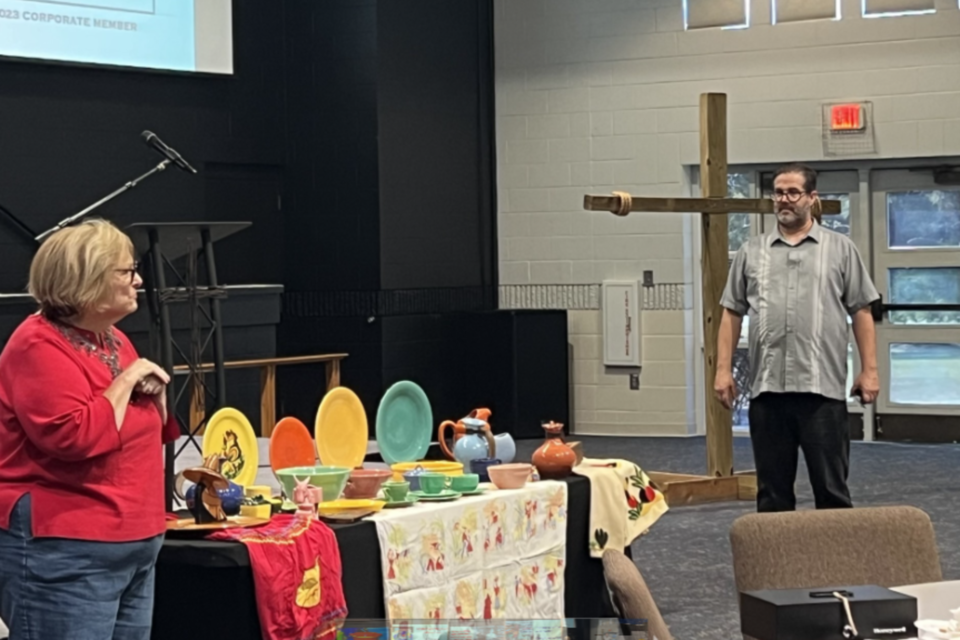The Bulloch County Historical Society met Monday, October 28, 2024 in the Pittman Park UMC Fellowship Hall. This month's program was about the famous, colorful Fiesta Ware, presented by Dr. Michael Van Wagenen, Associate Professor of History at Georgia Southern University.
Prior to the very enlightening presentation, the 65+ guests enjoyed a home-cooked lunch catered and served by A Touch of Class by Annette. The menu included cole slaw, chopped BBQ, potato salad, green beans, sliced bread, and cheesecake for dessert. Always delicious -- thank you, Annette!
For those not familiar, Fiesta Ware is a brand of ceramic glazed dinnerware introduced in 1936 by the Fiesta Tableware Company of Newell, WV, which originated from Homer Laughlin China company.
Fiesta Ware's original shapes and primary color glazes were designed by Frederick Hurten Rhead, Homer Laughlin's art director, in 1927 until his death in 1942. Its bright, bold colors, ceramic construction, mix and match concept, and durable and chip-resistant nature made it very popular for dining and special occasions.

FiestaWare represented something radically new to the general public, and Dr. Van Wagenen shared what sparked his interest in it, and being a Historian, how it relates to the history of the United States and Mexico.
He began this exceptionally interesting program with two questions ("How many collect vintage dinnerware?" and "How many collect specifically FiestaWare?") and a series of slides with a vivid display of FiestaWare through the decades. Many of the pieces highlighted in his presentation came from Bulloch County homes and families.
Van Wagenen said, “My interest in FiestaWare was merely practical. I was remodeling my kitchen and wanted good quality but affordable daily dinnerware. My house had a strong Mexican decorative influence, so Fiesta made a lot of sense. Curious if it had anything to do with international politics, namely Franklin Delano Roosevelt's ‘Good Neighbor policy’ in 1933, I started digging and discovered that the connection was much stronger than suspected. The Mexican-themed kitchen was popular among the US from 1933 to the mid 1950s, a golden era for the relationship between the US and their Southern neighbor Mexico."
Van Wagenen took a different approach to the history, looking at the impact of this policy on the decorative arts in the homes of working class Americans.
He said, “My casual interest grew into a major research project and museum exhibit.”

This brightly colored dinnerware became very distinctive, particularly in the late 30s, early 40s, and 50s. Before that time, Professor Van Wagenen shared that white dinnerware was most popular and imported from Europe, making it very expensive.
The cultural impact of FiestaWare represented American optimism in modernity and symbolized middle class prosperity with its timeless elegance and versatility in formal and informal settings.

“It was a creative period with Art Deco fusing with rustic nostalgia of the time. Homer Lawton China began producing Fiesta again in 1986, and a lot of Chinese factories began receiving the style and exporting it back to the US,” Van Wagenen said. Dinnerware was just part of the decorative art trend; many companies produced table linens, glassware, curtains and accessories, all with a Latin American flair.
Van Wagenen concluded, “While my focus today was on dishes, my larger study and exhibit will more thoroughly demonstrate the connection between International politics and the decorative arts in the US.”
“[This presentation] reminds us that, culturally, Bulloch County is and has always been connected to the wider world in ways that we often don't recognize," shared Brent W. Tharp, PhD, director of the Georgia Southern University Museum. "To think that the interaction of Mexico and the United States politically and economically in this period ultimately ended up influencing how our grandmothers served their meals and decorated their homes is fascinating.”




